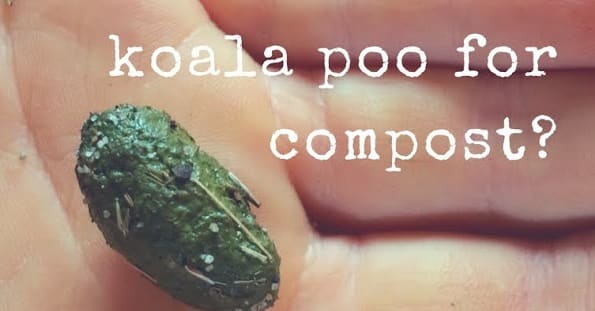An interesting question I was posed with today – can you compost koala poo?
As I write now in the late evening, I am listening to a great ‘symphony’ of koala calls outside – the ‘growling’ males and the squeaky young ones. The noises koalas make are really quite surprising – possibly some of the noisiest of the Australian natives – especially in mating season. You’d think there were great big monsters outside. Visiting friends and children can be quite alarmed!
 |
| Such soft and sweet-looking animals make such incredibly raucous noises all through the night. |
An easy way to find koalas is to look for their fresh scats below the gum trees. We’ve been encouraging this method after Hugh rode into a few garbage bins on the side of the road today !?! (he’s OK).
Koala scats are oval shaped and olive green when fresh, and as little Monty informs us, they smell of gum leaves which is not surprising since this is their entire diet.
Looking for native animal scats is actually quite fascinating. Other scats we’ve found belong to the Eastern Grey Kangaroo and the wallabies, but we haven’t spotted any echidna or wombat scats yet. We know there are wombats here, and we’ve seen lots of gorgeous echidnas with their amazing quills and feet – such lovely little faces – snuffling around in the leaf litter searching for insects.
So, can you compost native animal manure?
Herbivore poo is good poo for compost. A while ago I was going past a Llama farm and picked up a car boot full of llama poo which made great compost. Native herbivore poo also makes good compost although I hear it is generally slower to decompose. Also, being quite small, it would take a while to collect (unlike the llamas that poo all in one spot). Having said that, Koalas scat is often concentrated under trees so easier to collect than the poo of the wandering grazing kangaroos and wallabies.
We’ll go out with a bucket tomorrow and see how much we can collect for Grandad’s orchard.
Here’s a link to some scats for Australian animal scats: http://www.abc.net.au/science/articles/2007/09/26/2044094.htm



Aren't they noisy – like a ferocious wild pig stuck up in a tree! Lots of videos on YouTube for any overseas readers wanting to hear it. There's a good book available Tracks, Scats and other Traces by Barbara Triggs, that you may be able to get at your local library. Melindi
This is a really interesting post. And a bit nostalgic for me. I remember when I lived in the beautiful Lake District in England years ago, I used to take a wheelbarrow and the children up on the fells (hills) where the sheep roamed, to collect their droppings. Tiny hard little black pellets. They still remind me about having to struggle with getting a wheelbarrow over the dry-stone walls to get onto the fells. They didn't mind on the way up, but it was a bit dodgy on the way down with the droppings in the wheelbarrow. Happy days.